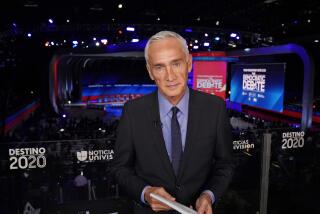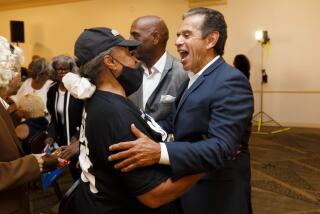Warmth, Protests Greet Philippine Leader
- Share via
Philippine President Fidel Ramos swept through Los Angeles on Wednesday as part of a four-day mission to strengthen economic and political ties with the Pacific Rim, finding a warm public reception at several of his speaking engagements but some protesters who oppose his policies.
Ramos, who met with Mayor Richard Riordan and spoke to members of the city’s large Filipino American population, is credited by many with bringing political stability and unprecedented growth to a nation once dubbed the “sick man of Asia.” Ramos applauded Los Angeles’ own business and technological development.
“Los Angeles has taken its position as a center of [economic] growth, it’s vibrancy reflected in its ever-busy airports, harbors and people,” Ramos told the mayor and council during a packed City Hall welcoming ceremony. The Philippines is “now No. 10 in trade with this city. . . . Why don’t we try for No. 5?”
In an effort to reach that goal, the 69-year-old president met with representatives of the city’s information technology industry and other business leaders.
And in a show of how closely they monitor their homeland’s politics, Filipino Americans--many with their children at their side--gathered to cheer Ramos during each stop along his itinerary.
Marivic San Gabriel, a Los Angeles city employee who took a break to see Ramos and the rest of the delegation at City Hall, said family members in Manila have benefited from the president’s policies.
“We used to send them quality clothing from here but now it’s available to them,” she said. “My family says there’s still poverty and problems. But things have gotten better.”
In a late afternoon visit to Carson--an enclave for many of Southern California’s 500,000 Filipino American residents--Ramos encountered similar applause. He met with Mayor Pete Fajardo, the first Filipino American mayor in the United States.
By evening, he was at the Los Angeles Convention Center, visiting with more business people and Filipino American veterans of World War II to support their fight for full benefits from the U.S. government.
More than 80% of the U.S. troops who defended the Philippines against the Japanese between December 1941 and the country’s fall in May 1942 were natives of the then-American colony. But the U.S. Congress has not granted them the full benefits accorded to other combat veterans, declaring their service during the war “inactive.”
The response was not all welcoming, however. Outside the center, about 70 protesters converged, saying Ramos’ neoliberal economic policies benefit only Philippine and transnational corporations--not small business owners and the poorest people.
“We are against Ramos’ reforms because of what they are doing to the majority of Filipinos, the peasants and indigenous people,” said Jay Mendoza, a spokesman with Bayan, a coalition of Filipino American groups critical of the president. “He is placing the economy in the hands of foreign controllers.”
The group also criticized a movement in the Philippines to keep Ramos in office beyond his single, six-year term, scheduled to end in June 1998.
At City Hall earlier, Ramos told reporters that he would continue his democratic reforms and not reappoint himself president, a prospect opponents view as a return to the dictatorial days of the late Philippine President Ferdinand Marcos, who suspended the constitution in 1972 to remain in power.
But Ramos also said he will take an “advisory” role in Philippine government when his term ends.
Mendoza charged that Ramos was “supporting the movement to extend his term behind the scenes” and that his plans for an advisory role are a violation of the nation’s constitution.
“Once he is out of power, he’s supposed to stay out,” he said.
Since 1992, when Ramos won the presidency of with a quarter of the vote, beating out six candidates, the Philippine economy has seen steady growth--7% in 1996, 5.7% in 1995 and 4% in 1994. The resurgence for the nation of 67 million came after years of stagnation when the annual growth rate was about 2%, less than the rate of population increase.
Power blackouts that regularly interrupted daily life in Manila have all but ended. Factories have sprouted at Subic Bay, site of the former U.S. Navy base.
Ramos, who arrived in Los Angeles on Tuesday, is scheduled to visit San Diego today and Friday.
More to Read
Sign up for Essential California
The most important California stories and recommendations in your inbox every morning.
You may occasionally receive promotional content from the Los Angeles Times.










